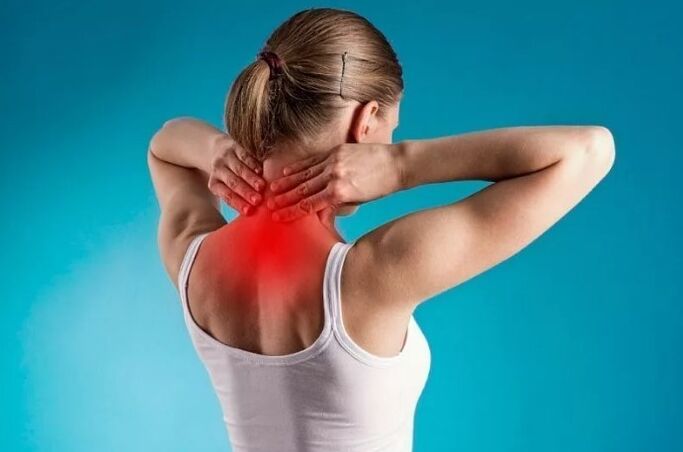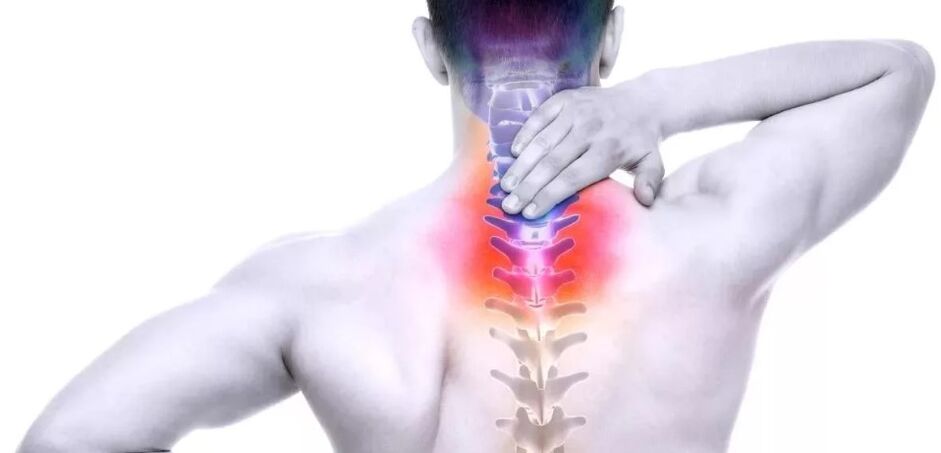Cervical osteochondrosis is a progressive dystrophic and deigenerative lesion of intervertebral disks in the area of 1-7 vertebrae belonging to the Cervical region.
As a result of thunderstorm, deformation, exhaustion, and then there is damage to the rumete bodies. This interferes with the normal supply of blood and nervous conductivity in the neck and in those areas that imposed the roots of the nerve cervix.
Cervical osteochondrosis can be isolated or combined with osteochondrose of other departments - lumbar and sacral.
Reasons

The causes of dystrophic and degenerative changes in the interfaced discs have not yet been studied enough. Assumption that osteochondrosis of the hay phenomenon confirmation. It is found even in children and adolescents.
It is characterized by a number of factors that predispose the development of osteochondrose. They include:
- Sedomer and Seedentary Lifestyle,
- Sitting types of work with static load on the neck,
- surplus weight, insufficient physical development,
- Displastic processes of connective tissue,
- Violation of blood circulation in the neck,
- Door injury,
- Scoliosis, disadvantages of holding, unpleasant pillows and mattresses,
- Hereditary predisposition, metabolic shortcomings.
Symptoms of cervical osteochondrose
Cerila cervical cerila, due to the characteristics of skeletons, directly, as well as a large size of the head, is especially vulnerable to the development of osteochondrose - the vertebrae in it are the smallest compared to other parts of the spine, and the muscle frame is not very spoken.
The most characteristic symptom that patients complain - pain in Cervical. Depending on the damage zone, the pain can be localized
- in collar and shoulder;
- Through the cervical spine;
- On the front surface of the chest.
Pain for cervical osteochondrose due to the characteristics of the cervical region.
The first signs of cervical osteochondorosis are insignificant and slightly specific:
- Neck pain in the evening,
- A sense of weight in the head, headaches in the occipital area,
- a feeling of stiffness or tingling in shoulders and hands,
- Cryst in the neck when turning your head, click on vertebrae.

Leading symptoms:
Vegetative-dissonent
- Quite strong neck pain and, especially, in the area immediately below the back of the head;
- pain occurs after a long stay in one position (for example, after sleep);
- The neck muscles are constantly tense;
- There are difficulties with abandoning hands aside;
- On the affected side of your fingers are limited in motion.
Since vertebrates are compressed, neurological events have been observed: headache, nausea, fainting.
Spinal symptom
The pain is localized behind the sternum on the left.
This type of pain should be distinguished from pain as in Angin Pectoris (with angina pectoris, nitroglycerin is mitigated, with osteochondrose - no).
By gradual violation of the structure of interverter discs, their compression (compression) and injury to nerve roots, as well as narrowing or violation of arteries and veins, which are held in the area of vertebrate.
This leads to the formation of special syndromes - radio capulators and ischemics.
- Defeat the root of the first cervical vertebrae (C1): violations affect the back of the head, reducing the sensitivity to the skin;
- Lesia C2 gives pain in the crown of the crown and the back of the head;
- Lesia C3 gives neck pain on the side of violation, reducing sensitivity in language and sub-municipality muscles, in some cases of speech impairment and loss of language control;
- Defeat C4 and C5 gives pain in the shoulder and clavicle, reducing the tons of head and neck, hiccups, respiratory disorders and heart pain;
- Defeat C6 is most often giving pain from door to spatula, forearm, to thumb, skin sensitivity may suffer:
- The C7 defeat gives similar symptoms with pain in the neck, the back of the shoulder, to the back of the hand, a breach of arms and reduction of reflexes.
Blood circulation disorders due to the compression of vessels in the area of cervical vertebrae, heavy dizziness, visual damage and ears in the ears, clapping flies in front of the eyes, autonomic functions.

It is possible to manifestations of heart syndrome with compressive heartache, lack of air and heartbeat, rhythm disorder.
Complications
Serious complications of cervical osteochondrosis are
- Probling of interfaced discs with the formation of a herninia (protrusion);
- The rupture of an intervertebral disk with a violation of nerves and blood vessels, is possible to compression of spinal cord, which can lead to death;
- I can also be radicalopathy (root lesions), formation of osteophytes (spikes on the vertebra) with a manifestation of paresis and paralysis.
Diagnostics
In the presence of the above appeals, the appeal is necessary to an orthopedic doctor or neurologist.
First of all, the doctor will evaluate mobility and neck in neck, sensitivity and other functions. Then there will be a necessary radiography of the thrain spine in several projections, if necessary, calculated tomography or magnetic resonance scanning with suspicion of the pothole.
In the event of a circulation disorder, Rheoencephalographs and fundus examination will be needed.
Cervical osteochondrose treatment
Today, there are also traditional and nontraditional methods for the treatment of osteochondrose in the Grlić spine.
Conservative methods are mainly used:
- Symptomatic therapy analgesics to relieve pain syndrome
- Receipt of anti-inflammatory drugs of the Nerester Series - To mitigate inflammation and edema tissues
- An antispasmodics and drugs to improve blood circulation are used to remove muscle cramps.

In the treatment of cervical osteochondorosis, substances that return the structure of intervertebral discs - Chondroprotectors.
The Group B Group B Course is displayed, external therapy products apply - gels and fats, creams with anti-intentional and analgesic components. It shows the stimulants of regeneration of interfaced discs.
Surpassing and general massage, acupuncture, physioteceptions, physiotherapy and gymnastics and gymnastics helps to treat osteochondrose. The osteopathy method has shown well - a slight effect on "clamped" muscle and vertebrae zones.
In the treatment of cervical osteochondrosis, it is recommended to wear a special collar (Shantsa collar).
Complications of cervical osteochondrose with kilos that violates sensitivity and blood circulation can be treated immediately.
The duration of the treatment depends on neglecting the situation, because osteochondrose is a progressive chronic disease. Treatment can be debt, and preventive courses are performed for life.
Proper nutrition will help mitigate the conditions for osteochondrose.
Exercises for cervical osteochondrose treatment:
- Just ejection: In position with the right back, it is necessary to lower your shoulders as little as possible, while the neck must be pulled. It is necessary to make at least 10 accesses at least 3 times a day.
- Self-consideration: Grace next to the neck with a towel, getting him to the end and pull it alternately, spreading the neck muscles. In this case, it is necessary to ensure that the towel does not slide along the door.
- Gymnastics for the cervical region for osteochondrose: small bending of necks, as well as the turn and slope of the head , . There are 5-7 folders in each direction in each direction. This exercise is most useful for performing after the self-adjusting of the neck spine.
Prevention
The basis of the Health of the BRLIC spine is a strong and healthy back, physical activity, a comfortable bed with anatomical cushions and mattress, proper posture and proper nutrition.
Validation of neck injuries and weight lifting. It is necessary to combine long-term seating with periods of rest and heating.























